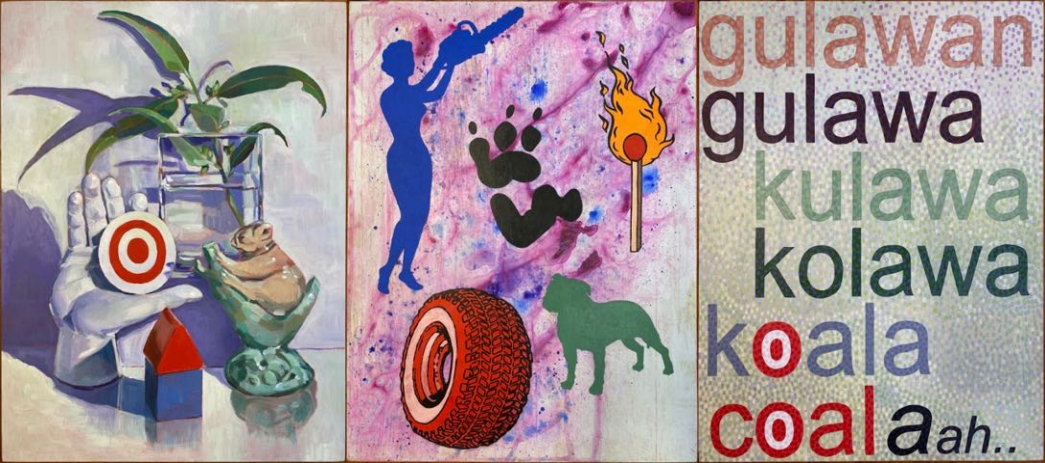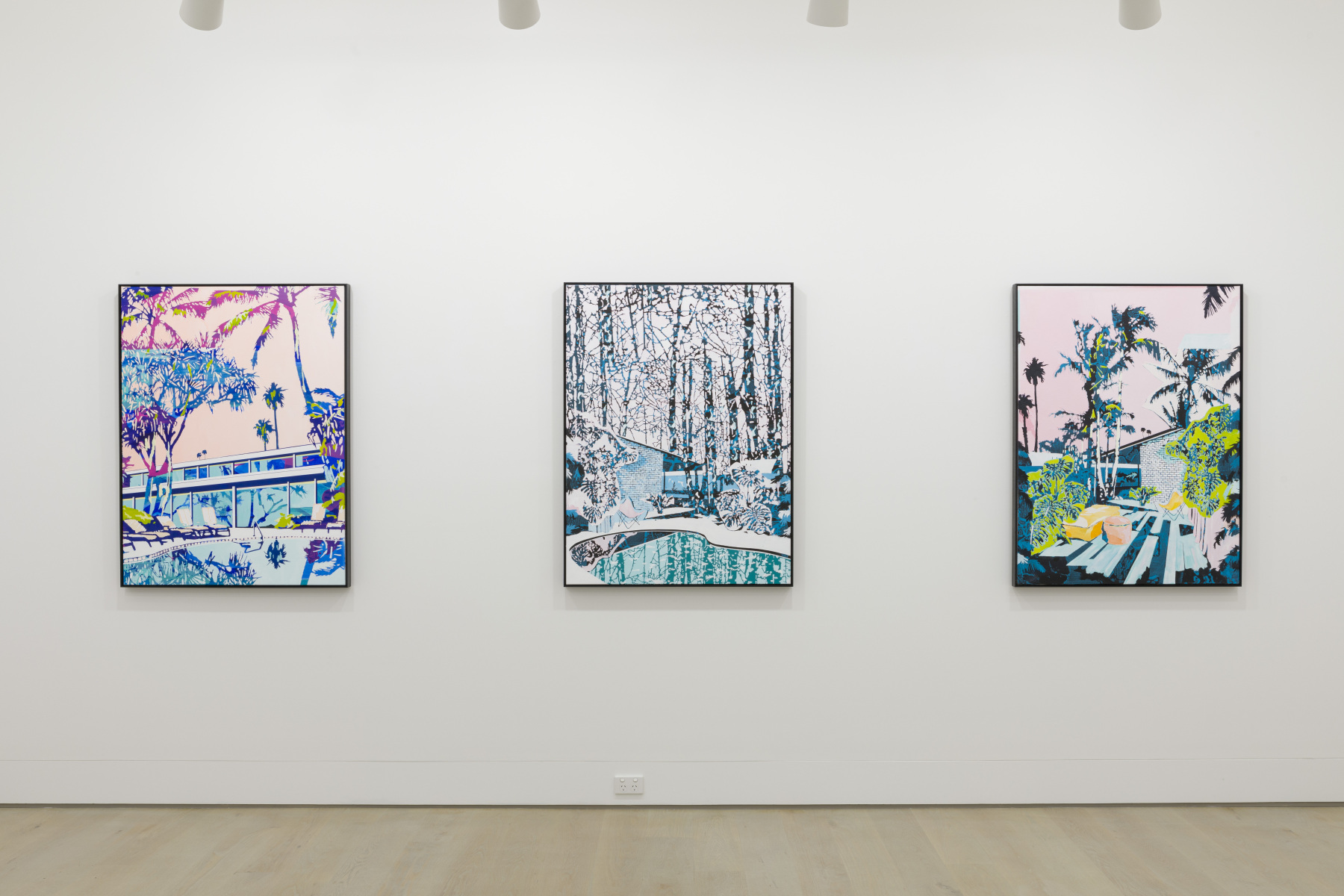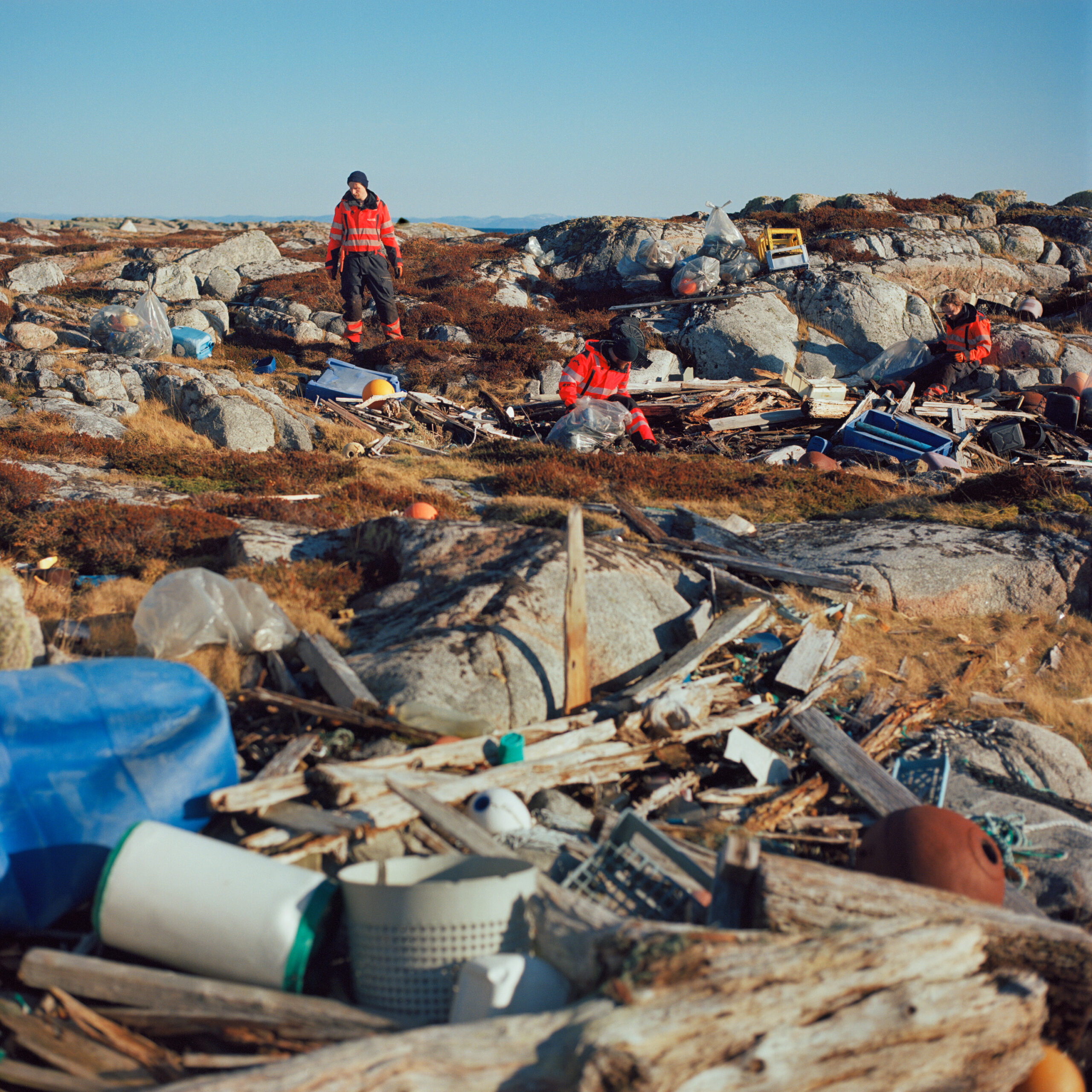Two exhibitions opened their doors on the 21st of November: Paul Davies’ Memory lens and Leigh Schoenheimer’s An Unnatural History.
Memory lens, Paul Davies’ first solo exhibition with Jan Murphy Gallery, sings in the sleek, white, high-ceilinged exhibition space. His artworks form a cohesive body with their melt-in-the-mouth pastel colour palette depicting recurring images: re-imagined architectural images embedded in nature. Davies often uses a pool as a visual connection between the built environment and the landscape, their curved fluidity leading the eye towards bold, rectangular, architectural spaces.
Davies’ work activates both nostalgia and imagination, a paradoxical mix of past and future connections. His use of saturated colour, layering, and perspective draw the viewer into a memory of a place, suggesting: come and sit in this chair, go for a dip, open the door, step inside. His conscious choice to leave his urban landscapes devoid of people (or, in some works, adding only a shadowy ‘human hint’) allows us to meander through his spaces unhindered.
Davies’ style is contemporary and playful with a David Hockney feel. As the exhibition title suggests, Davies enters his creative process via a camera lens: he grew up watching his father conjure images into being in a darkroom in the family home. This set him free to play with images: flipping and inverting them, changing negatives from night to day, turning up the volume on colours, and switching them around, creating a kaleidoscopic, dreamlike feeling in his paintings that is both real and unreal.
For example, in Untitled 12 (2023) we see towering multi-coloured, palm trees reach into a pastel pink sky, their fractured, equally multi-coloured reflections, falling into an impossibly aqua pool, which laps against the feet of a two storey, ultra-marine and square dwelling, flecked with orange-yellow deck chairs. In this work, water provides another opportunity to play with images. By contrast, Untitled 11 (2023) sees Davies using a more sombre colour palette, employing gradations of blue evocative of a film negative. Rather than sundrenched skies we are enveloped in a quiet snowscape at night. A smudge of pastel pink shows us the dwelling and we are drawn in, wanting to wade through the colours, open the door and make ourselves cosy.
Davies’ familiar, iridescent subjects are luxurious. We venture through mature trees into sumptuous outdoor spaces, which in turn, invite us into beautifully designed, architectural spaces. Reflecting his time spent painting in California, in true Hollywood fashion, his works ask the viewer, ‘What’s your dream?’ and ‘What do we find in the spaces between glamour and reality?’
Leigh Schoenheimer’s love for exploring real life objects in an increasingly abstract and conceptual way, is thought provoking and tactile, as well as a feast for the eyes. Her exhibition, An Unnatural History, comprises two bodies of work. The Meaning of (Still) Life: An Unnatural History, characterised by a retro-feeling colour palette, dovetails with the lush and deliciously vibrant colours of Still-Scapes, wherein many will recognise the stunning vistas around the Tweed Valley. Both series explore Australian environmental concerns: the former focusing on endangered fauna and the latter addressing the impact of weeds on native flora. Thoughtful placement of Schoenheimer’s quirky assemblages, made from eclectic found objects, provides additional visual appeal to this exhibition, tweaking the viewer’s imagination as familiar objects take on new meaning. Look out for Woman with Top Knot for a humorous interpretation of the female form! (Catalogue #20)
Schoenheimer is an experienced art educator. Consequently her work is well-researched and informed, sparking connections with Modernist and Post-Modernist artists such as Miro and Calder. Her use of diptychs and triptychs creates a unifying language of multi-image ‘storyboards’, inviting engagement from varying angles and perspectives. Schoenheimer’s use of still life images in the first panel of her diptychs and triptychs provide the viewer with a familiar entry point to access concepts and connections, with the addition of text elements adding to this experience.
Schoenheimer’s The Koala (from The Meaning of (Still) Life) demonstrates this well with the first panel of the triptych depicting a still life image of a ceramic koala that we can readily engage with. The crimson-splattered second panel, scattered with ‘clip-art’ style imagery of forces that endanger the koala’s existence, jar us into an examination of human impact on the environment. The third panel, Schoenheimer introduces text with intelligence and impact. First Nations’ words for Koala sit alongside their English translation and a word-play on ‘coala,’ deftly steering us toward an examination of colonialism on native animals. Evoking Jasper Johns, the target symbol is a recurring motif throughout Schoenheimer’s art making, and its use in this work is particularly powerful.
In Still-Scape: Tweed Weeds, gorgeous and painterly still life flower imagery and colour-soaked serene landscapes are juxtaposed with computer keyboard commands such as ‘ALT,’ ‘DELETE,’ and ‘UNDO.’ Merging the real with the virtual, these act like ‘click bait,’ accessing pull-down tabs in viewer’s minds for further exploration and connection—and action. This is a bittersweet experience, as we ponder the fact that the still life depicts a weed and a landscape that has been heavily impacted upon.
Memory lens and An Unnatural History are a visual feast, enticing the viewer in with lush colours and re-invented familiar imagery. Both Davies and Schoenheimer explore human impact on the land in different ways. While Davies draws us into a dreamlike familiar world that evokes memory, imagination and aspiration, Schoenheimer uses everyday objects and landscapes to stimulate appreciation of Australia’s native flora and fauna and an awareness of our part in protecting it.
Paul Davies: Memory lens
Jan Murphy Gallery, Meanjin/Brisbane
21 November-9 December 2023
Leigh Schoenheimer: An Unnatural History
Woolloongabba Art Gallery, Meanjin/Brisbane
21 November–2 December 2023
Meg Rowe is a writer and teacher with a passion for art. She lives and works in Meanjin.







